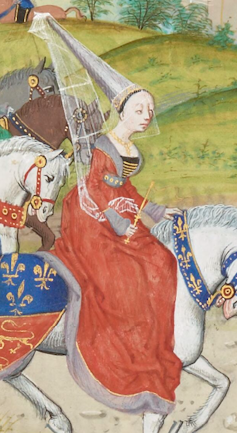A new statue of Dervorguilla of Galloway was installed in the Master’s Court of the University of Oxford’s Balliol College in September. She was the 13th-century cofounder of Balliol and its first benefactor.
Carved from a single block of limestone by artist Alex Wenham, it was described by the college as “a valuable contribution to Oxford’s public art, where statues of women – particularly those outside royal or religious contexts – remain sadly rare”.
Wenham’s Dervorguilla has the f…
A new statue of Dervorguilla of Galloway was installed in the Master’s Court of the University of Oxford’s Balliol College in September. She was the 13th-century cofounder of Balliol and its first benefactor.
Carved from a single block of limestone by artist Alex Wenham, it was described by the college as “a valuable contribution to Oxford’s public art, where statues of women – particularly those outside royal or religious contexts – remain sadly rare”.
Wenham’s Dervorguilla has the feeling of a time traveller, at once both medieval and modern. The smooth contours of her recognisably 13th-century form emerge, polished, crisp and authoritative, from the unworked stone around her.
The statue’s commission speaks to a strong drive to populate urban spaces with more monuments to women. Since the Lloyd’s Register Foundation reported in 2018 that fewer than 3% of statues in the UK were of real, non-royal women, several campaigns aimed at documenting and achieving greater gender representation in public art have gained a foothold.
But medieval women themselves shaped the built heritage of our towns and cities. Too often, their efforts have been hidden or ignored, and their legacies neglected.
The women who shaped our cities
Painting of Dervorguilla of Galloway by Wilhelm Sonmans (1670). Bodleian Libraries, University of Oxford
My research considers how women used architectural patronage to fashion their identities and curate their legacies in the public realm. In Dervorguilla’s case, her statue complements a living, breathing foundation she brought into being. Even if the buildings of the college today are not ones her 13th-century eye would recognise.
Dervorguilla’s significance as Balliol’s co-founder, however, has been minimised throughout much of the establishment’s history. The college was named after her husband, John Balliol, but Dame Helen Ghosh, master of the college, recently commented it might just as appropriately have been called “Dervorguilla College”.
Ghosh explained that it was Dervorguilla who “did the practical work to set us up, writing our foundational Statutes and financing our first buildings on Broad Street”.
Balliol was not Dervorguilla’s only foundation – she also founded the Cistercian abbey of Dulce Cor in Scotland. It’s known as Sweetheart Abbey, because Dervorguilla was laid to rest there, clutching her husband’s heart – which she had kept in an ivory casket – to her bosom.
Nor was Dervorguilla the only medieval woman to leave a lasting mark on the built environment through her patronage. Many others commissioned foundations during their lifetimes and many of them continue to exist in tangible form, right under our noses. Like Dervorguilla, their actions have often been hidden behind those of male relatives, or overlooked entirely.
Magdalen Chapel, Cowgate, Edinburgh. Wiki Commons, CC BY-SA
As creators and benefactors of educational, religious and charitable institutions – from university colleges and schools to churches, hospitals and almshouses – women of means found ways to circumvent the patriarchal power structures of medieval society.
They made themselves visible through acts of charity, piety and self-memorialisation. These women created more than just monuments. They left behind significant cultural and artistic legacies as dynamic testaments to their identities and ambitions.
Today, however, many of those foundations are little-known or awkward outliers in fast-paced and ever-evolving urban environments.
Trinity Apse in Edinburgh is a case in point. Once part of a grand collegiate foundation commissioned by Mary of Guelders, Queen of Scots in 1460, the church was dismantled in the 19th century to make room for platform two of Waverley train station.
After several years, numerous stones were salvaged and a partial rendering of the original church was reconstructed. It’s just behind the Royal Mile in a high-end IKEA flatpack-style reconfiguration now known as Trinity Apse. Though Grade A listed (the highest category of listing in Scotland), the Apse’s future as a publicly accessible heritage site hangs in the balance.

Isabella Queen of France by Froissart (1475). Gallica
Just round the corner from the Apse on Cowgate – an area of Edinburgh famed for its lively nightlife – stands a pre-Reformation chapel. It contains the tomb of Jonet Rhynd. Rhynd was a local businesswoman responsible for overseeing the construction of the chapel and its associated almshouse, following the death of her husband in 1537.
Take a trip south to the Midlands and in Coventry you’ll find St John the Baptist Church. It was originally founded in 1344 by Queen Isabella of France as a chapel in memory of her family, but is now on the Heritage at Risk register.
Closer to Balliol, in Oxford, are the picturesque ruins of Godstow Abbey, founded by Edith of Winchester in 1115. Overlooked for many years, only in the last decade has the addition of an interpretation board put the abbey, and the story of its female founder, back on the map.
Many of these buildings and structures face a complex web of challenges. Not only are they expensive and complicated to maintain, their origins as religious foundations also adds to their precarity in a climate where the relevance of church buildings is hotly debated.
For the women who founded them, however, patronage was the language through which they made their voices heard. If we are seeking to reassert women’s presence in our public spaces, where better to look than to the very legacies they themselves constructed.

Looking for something good? Cut through the noise with a carefully curated selection of the latest releases, live events and exhibitions, straight to your inbox every fortnight, on Fridays. Sign up here.